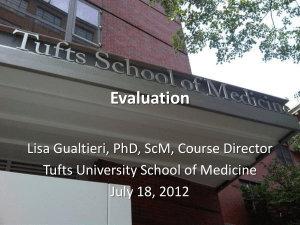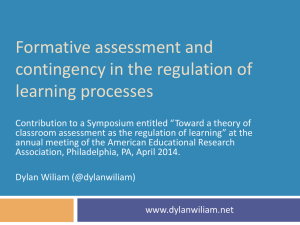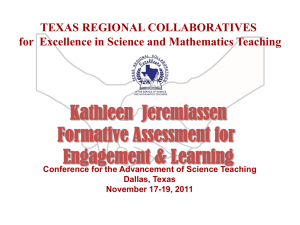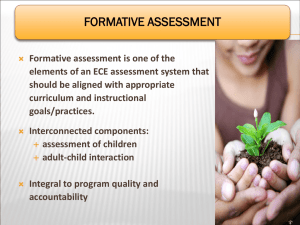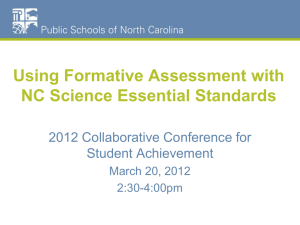Why Formative Assessment? - NSTA Learning Center
advertisement
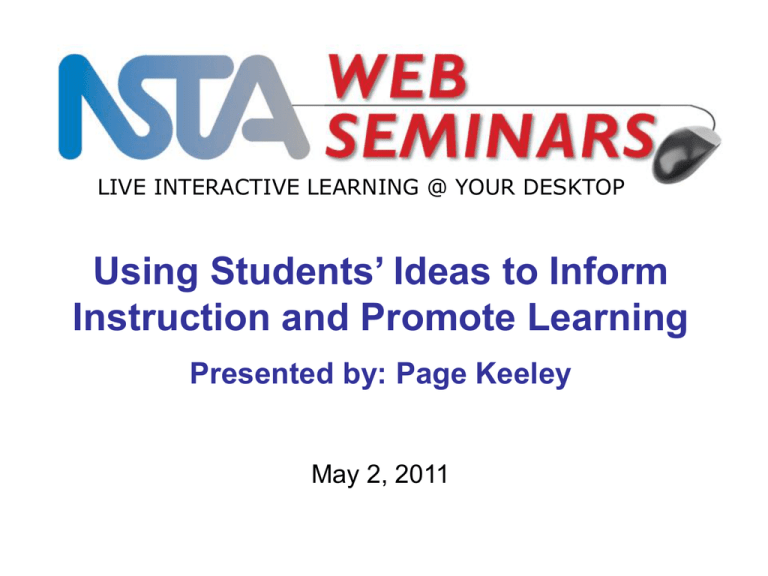
LIVE INTERACTIVE LEARNING @ YOUR DESKTOP Using Students’ Ideas to Inform Instruction and Promote Learning Presented by: Page Keeley May 2, 2011 Formative Assessment in Science: Using Students’ Ideas to Inform Instruction and Promote Learning Page Keeley Maine Mathematics and Science Alliance NSTA Past President NSTA Press Author During This Seminar You Will: • Distinguish formative assessment from other types of assessment • Learn about the research that supports formative assessment in science • Examine a variety of formative assessment probes and FACTs •Consider ways you will use formative assessment in your practice What is the first word you think of when you see the word…. nsta.org ASSESSMENT Transformative Assessment Assessment that fundamentally transforms teaching, learning, and the culture of the classroom 3 Types and Purposes of Assessment • Diagnostic- To identify and analyze preconceptions (including misconceptions) and learning difficulties. • Formative- To inform instruction and provide feedback to students on their learning. • Summative- To measure and document the extent to which students have achieved a learning target. * Note: Diagnostic assessment becomes formative when the assessment data is used to inform instruction. The Dr. House Metaphor Key Point #1 Assessment is not formative unless you use the information to plan or modify your instruction with the intent to support learning. Why Formative Assessment? Why are more and more educators touting the instructional virtues of formative assessment? The Claim: Formative assessment, properly used in the classroom, improves learning. This claim is supported with evidence from a meta-analysis of empirical data in which researchers conclude that student gains in learning triggered by formative assessment are “among the largest ever reported for educational interventions.” Black and Wiliam 1998 Support for Formative Assessment Continues to Grow… • • • • How Students Learn Assessment for Learning Taking Science to School Ready-Set-Science Key Finding from How People Learn “Students come to the classroom with preconceptions about how the world works. If their initial understanding is not engaged, they may fail to grasp the new concepts and information that are taught, or they may learn them for purposes of a test but revert to their preconceptions outside the classroom” How People Learn, Bransford, Brown & Cockling. pp 14-15 Wealth of Research Poverty of Practice Key Point #2 Formative assessment in science differs from other subject areas such as ELA due to its conceptual nature and the impact preconceptions have on student learning. For this reason, formative assessment cannot be a “one size fits all disciplines” generic approach. Science teachers must have access to specific tools for formative assessment that target the content they teach. Formative Assessment Classroom Techniques (FACTs) 75 Practical Strategies for Linking Assessment, Instruction, and Learning nsta.org Tools and Resources Key Point #3 “Misconceptions” are strongly held. It takes time and carefully designed instruction to help students give them up. Correcting students’ misconceptions before they have an opportunity to think through their ideas and modify them does not support conceptual change. Schema Students’ Ideas (Conceptions) • Are strongly held • Differ from expert conceptions • Affect in a fundamental sense how students understand natural phenomena and scientific explanations • Must be “overcome” in order for students to achieve scientific understanding Formative Assessment Probes A probe is a purposefully designed, multigrade level question that reveals more than just an answer. A probe elicits a response that helps teachers identify students’ ideas about phenomena or concepts. Probes are also used to engage students, encourage thinking, and promote sharing of ideas. Most Common Response It’s because the Earth orbits closer to the sun in the summer than in the winter. P-Prim: Closer- stronger Representations- Earth’s exaggerated elliptical orbit Tilt Representations can contribute to misconceptions 3 Minute Pause Egg Timer Talk Use the chat to post any comments or questions so far…. Key Point #4 Probes and FACTs are assessments for learning- they differ from summative assessments in that they not only inform instruction, they also promote learning. For that reason, they should NOT be graded. Juicy Question Poll Question A. I think an egg will gain mass just before hatching. B. I think an egg will lose mass just before hatching. C. I think the mass of an egg stays the same as the chick develops inside. Human Scatter graph Gain Lose Same Low confidence High confidence Prior knowledge of: • Food- what it is and what it is used for • Transformation of matter • Growth and development (including experience incubating eggs) • Conservation of matter • Open versus closed systems • Permeability of materials • Gas exchange Key Point #5 To use formative assessment effectively, you must establish a safe classroom environment where all students’ ideas, regardless of whether they are right or wrong, are encouraged, respected, and valued. Use clip art to indicate the best choice for where most of the matter that makes up a large tree comes from. A. Sunlight B. Water C. Soil D. Carbon dioxide E. Oxygen F. Minerals G. Chlorophyll FACT: Commit and Toss FACT: Sticky Bars Key Point #6 Formative assessment is purposeful. Probes and FACTs are always linked to a teaching and learning outcome. Collect formative assessment data with intention and act on it purposefully. Elementary Goal Plants need: water sunlight air Plants make their own food Middle School Goal High School “The world looks so different after learning science… For example, trees are made of air, primarily. When they are burned, they go back to air, and in the flaming heat is released the flaming heat of the sun which was bound in to convert the air into tree. And in the ash is the small remnant of the part which did not come from air, that came from the solid earth, instead. These are beautiful things, and the content of science is wonderfully full of them. They are very inspiring, and they can be used to inspire others.” Richard Feynman Key Point #7 Formative assessment probes and FACTs support development of communication skills. Use formative assessment to provide opportunities for students to share their thinking and engage in argumentation using claims and evidence-based reasoning. FACT: Card Sort Things that can reflect light Things that can’t reflect light Don’t agree or Need more information Most common “rules” • Shiny • Smooth • Light-colored Where did these commonly held ideas came from? How would this inform your instruction? 3 Minute Pause Egg Timer Talk Use the chat to post any comments or questions so far…. Key Point #8 Formative assessment is used continuously throughout an instructional cycle: before teaching- to elicit students’ ideas, throughout an instructional unitto monitor learning and provide feedback, and at the end- for reflection. 10 Purposes Linked to Instruction • Elicit and identify preconceptions • Engage and motivate students • Activate thinking and promote metacognition • Provide stimuli for scientific discussion • Initiate inquiry • Formal concept development and transfer • Improve questioning and responses • Provide feedback • Peer and selfassessment • Reflection Initiate Inquiry: P-E-O Probes • Predict • Explain • Observe Revise Explanation 8th Grade Responses • A- Because there are holes in it and things that have holes will sink. If a boat has a hole in the bottom then it will sink. • B- I think that the material will barely float. I think that it will barely float because the holes in it will allow some water to go through, but not enough for it to sink. • C- This is because the holes are two-sided. This means that the water can’t fill up the holes and make the material sink, so it has to float. • D- It will bob up and down because if there are holes in it then it will just be at the surface but it will also sink from time to time. Teacher Notes • Key Idea from National Standards: Density is a characteristic property of matter that is independent of shape or size of sample. • Consideration for Instruction: Distinguishing “mixed density” from “solid density” Related Research: Students take into account 4 factors when considering how objects float. The role played by: 1) material and weight 2) shape, cavities, and holes 3) air 4) water Even when taught that holes through solid objects do not change the object’s ability to float, the idea was still firmly held by students. Questioning and Response Strategies • • • • • • No Hands Questioning Hot Seat Questioning Popsicle Stick Inner Cup Questioning Wait Time Volley Ball Not Ping Pong Answer a Question- Ask a Question Reflection FACT I used to think _________________ But now I know ________________ Use the chat to complete your own “I used to think __ but now I know __” As it pertains to anything you learned tonight. Final Key Points #9- Formative assessment yields greater results in a collaborative school culture where teachers share student learning data, and work together to refine their use of formative assessment. #10- Start small- pick one probe or FACT, try it out, and evaluate its success before trying multiple strategies. Coming Soon! (July 2011) Visit the uncoveringstudent ideas.org web site for more tips, strategies, and information on science formative assessment. Thank you to the sponsor of tonight's Web Seminar: This web seminar contains information about programs, products, and services offered by third parties, as well as links to third-party websites. The presence of a listing or such information does not constitute an endorsement by NSTA of a particular company or organization, or its programs, products, or services. http://learningcenter.nsta.org http://www.elluminate.com National Science Teachers Association Dr. Francis Q. Eberle, Executive Director Zipporah Miller, Associate Executive Director Conferences and Programs Al Byers, Assistant Executive Director e-Learning NSTA Web Seminars Paul Tingler, Director Jeff Layman, Technical Coordinator LIVE INTERACTIVE LEARNING @ YOUR DESKTOP

